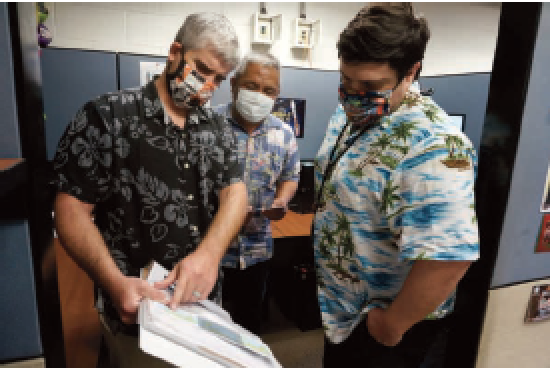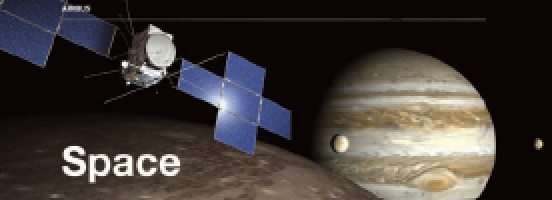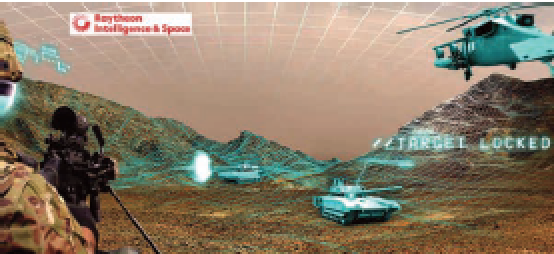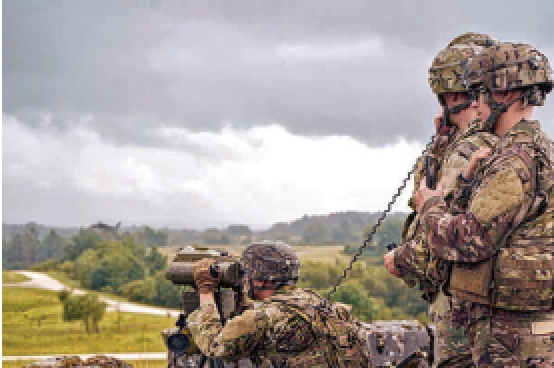Army Satellite Operations Brigade provides communications assistance for cyclone’s aftermath
The U.S. Army Satellite Operations Brigade’s Regional Satellite Support Center-Pacific, supported humanitarian assistance and disaster relief efforts for Cyclone Yasa, which battered Fiji’s Vanua Levu Island, Dec. 17.

Wideband satellite communication planners from the
Regional Satellite Communication Support CenterPacific at
Wheeler Army Air Field, Hawaii, discuss satellite planning
options to support a customer's request for SATCOM
resources in March 2020. The RSSCPacific belongs to the
U.S. Army Satellite Operations Brigade, U.S. Army Space
and Missile Defense Command. Photo courtesy of Iwalani
Gutierrez — Photo By Staff Sgt. Aaron Rognstad)
A team of Army Space Soldiers from RSSC-Pacific assisted with wideband satellite communications for the mission by processing satellite access requests, two of which went to the Australian Defense Force and two went to the New Zealand Defense Force.
“I can safely say on behalf of our entire team, it is very gratifying to support these humanitarian assistance/disaster relief efforts,” said Iwalani Gutierrez, RSSC-Pacific director. “Knowing that what we do matters helps the team get through the long days of 12-hour shifts in our 24/7 operations. This Fiji relief effort happened during the holidays, and my team can be relied upon to stand watch ready to respond to any contingency in support of our customers.”
Planning for satellite access solutions was primarily provided by two Soldiers, Sgt. Ryan Chilton of the Australian Defense Force and Staff Sgt. Felix Loperena, and one civilian contractor, Joe Myers, at the RSSC-Pacific located at Wheeler Army Air Field in Hawaii, December19-21, 2020.
Chilton is attached to RSSC-Pacific as part of the Australian Cooperative Partnership Program.
“When you sign up for this job, you always think you might be involved in missions of these types,” Chilton said. “Then something comes along like this where you ARE actually part of a real-world operation that really makes a difference in people’s lives.”
Vince Street, a civilian contractor, and Sgt. Devon Lenz also assisted with satellite operations for the mission.
“These (missions) are of the utmost priority,” Lenz said. “Anytime you have a disaster of this magnitude and you’re called upon to help out, you are going to do your part as best you can.”
As many as 93,000 people were affected by the cyclone — a high-end category 5 storm that registered winds up to 214 mph according to the Joint Typhoon Warning Center. Four people were reported dead and the cyclone caused about $1.4 billion in damage to health facilities, homes, schools, agriculture and infrastructure. The cyclone was one of the strongest storms ever recorded in the southern hemisphere.
The U.S. Army Satellite Operations Brigade’s Satellite Communications Directorate executes U.S. Space Command’s assigned mission for both wideband and narrowband SATCOM systems. The four RSSCs, which are located at Wheeler Army Airfield; Peterson Air Force Base, Colorado; MacDill Air Force Base, Florida; and Patch Barracks, Stuttgart, Germany, provide 24/7/365 SATCOM planning, engineering and satellite payload management for all Department of Defesne (DoD) SATCOM systems.
The RSSCs work with regional SATCOM users planning and authorizing critically required connectivity for system users across the full range of military operations including diplomatic, humanitarian assistance, disaster relief and scientific missions in zones where the communications infrastructure can be destroyed, degraded or is simply non-existent.
The Satellite Operations Brigade belongs to the U.S. Army Space and Missile Defense Command.
Story by Sgt. 1st Class Aaron Rognstad U.S. Army Space and Missile Defense Command
New AFRL collaboration with NSF INTERN program opens aperture for recruiting top talent
The Air and Space Forces will start 2021 with a fresh new partnership between the Air Force Research Laboratory (AFRL) and the National Science Foundation (NSF) designed to advance the scientific and innovation skills of the United States and draw a whole new generation of globally-competitive, diverse scientists and engineers into the AFRL innovation ecosystem.

The partnership formalizes an opportunity for current and future NSF-funded graduate students to participate in six-month internships onsite at any of eight AFRL technology directorates. There they will get access to professional development and practical work experience in Air and Space Force-related areas, also known as Core Technical Competencies.
“We see this partnership as a real win-win for AFRL and NSF as it aligns with the strategic workforce development goals of both organizations,” said AFRL Chief Technologist, Dr. Timothy Bunning.
AFRL is responsible for leading the discovery, development, and delivery of warfighting technologies for the air, space, and cyberspace domain. Its success depends on a high-quality network of internal workforce and external partners who are knowledgeable of Air and Space Force science and technology challenges.
“Strengthening and formalizing this partnership with NSF allows us to deepen and expand our ecosystem by fostering the training and preparation of a new generation of science and engineering talent to serve our strategic needs,” added Bunning.
A long history of collaboration between the NSF and the Air Force Office of Scientific Research (AFOSR) — the AFRL technology directorate responsible for managing Department of the Air Force basic science funding—helped pave the way for this new partnership.
For nearly 70 years, AFOSR has worked in tandem with NSF and other fundamental science funding agencies in pursuit of new scientific knowledge largely found in the laboratories of U.S. and international universities. AFOSR then helps relay that knowledge to applied research projects in support of national defense.
Dr. Prakash Balan, Program Director at the NSF, worked closely with the AFRL/AFOSR team in shaping this opportunity. “This partnership addresses the strategic workforce development objectives of the NSF. It provides a powerful opportunity for NSF supported graduate students to gain valuable experience and training, working closely with the scientists and technologists at the AFRL,” he said.
“We already had so many instances of scientific and programmatic collaboration between AFOSR and NSF that serving as the liaison between the NSF INTERN program and the other AFRL technology directorates under the auspices of the AFRL Chief Technology Office fit well within our sphere of impact,” said Dr. Van Blackwood, the AFOSR Science and Engineering Division Tech Advisor and key facilitator of the partnership. “It was also a wonderful way for us to demonstrate our commitment to the objectives outlined in the U.S. Air Force 2030 Science and Technology Strategy.”
The Research Internships for Graduate Students at Air Force Research Laboratory (NSF-AFRL INTERN) Supplemental Funding Opportunity went public on December 11, 2020, when NSF issued a NSF Dear Colleague letter explaining the new opportunity.
Read more about eligibility requirements and the broad AFRL opportunities available for graduate students at Dear Colleague Letter: Research Internships for Graduate Students at Air Force Research Laboratory (NSF-AFRL INTERN) Supplemental Funding Opportunity at this direct infolink...
AI assists with better battlefield intel
For future battlefield operations, speed is the name of the game. The side that can make decisions faster has the advantage.

A new, AI-enabled effort by the U.S. Army can give operators the ability to detect, identify, process and engage targets quicker than ever and at longer ranges than before.
The Tactical Intelligence Targeting Access Node, or TITAN, from Raytheon Intelligence & Space offers frontline forces, as well as headquarter commanders, a resilient tactical ground station capable of rapidly sifting through massive amounts of incoming sensor data to find and track potential threats. TITAN can connect to the future Joint All-Domain Operations enterprise, an all-domain, interconnected network to plan and execute operations in a synchronized, collaborative and streamlined manner.
“The goal of TITAN is to link Army commanders at all echelons to timely intelligence data, speeding up the data-to-decision timeline,” said David Appel, Vice President for Defense and Civil Solutions for Raytheon Intelligence & Space (RI&S), one of the four businesses that form Raytheon Technologies. “Today’s systems limit timely access to the intelligence information needed to engage in the ‘deep fight’ – distances greater than 200 miles.”

U.S. Soldiers, assigned to the 2nd Cavalry Regiment, scan
sectors of fire during the AH64 Apache helicopter gunnery
training in Grafenwoehr Training Area, Germany, in 2020.
U.S. Army photo by Sgt. LaShic Patterson.
RI&S is developing a TITAN solution that uses machine learning and AI to automate data processing that today is largely done manually. Integrating this technology into the process helps build a strong human-to-machine teaming relationship — reducing the mental strain placed on soldiers.
“Commanders on the front line need to quickly identify and assess threats to their forces,” said Greg Hansel, an RI&S business development manager. “To do that accurately, they need a system that can rapidly collect and fuse data gathered from every available sensor – regardless of domain – and quickly share the information with them. The goal is to speed up how fast data moves from sensor to the executing platforms, such as aircraft, artillery or jamming systems.”
RI&S's TITAN system combines Commercial Off-The-Shelf (COTS) technologies with battle-proven defense technology to provide users with uninterrupted access to data in contested environments, and to give them a clear picture of threats that evolve constantly.
“The commercial companies we are partnering with are developing the software running in the background of products people use every day to navigate the digital world, but they’re not necessarily designed for military use,” said Erik Grant, Chief Engineer for Defense and Civil Solutions. “We work with them to adapt and harden their products, ensuring they can operate in very high-consequence environments on no-fail missions.”
To ensure the TITAN solution continues to be effective as the future Joint All-Domain battlefield evolves, RI&S designed the system for scalability using an open-architecture development approach. The standardized design keeps the cost of maintenance low while enabling upgrades to be rapidly pushed to the system and provide the flexibility needed to integrate future capabilities as new threats emerge.
“We have to find innovative ways to continuously deliver new technology that meets our customers’ mission needs, period,” Appel said. “We can’t get hung up on where the technology comes from, be it the traditional defense industry or commercial partnerships, we have an obligation to bring the best capability to the table. Ultimately, what we deliver is going to protect our service men and women.”
Comtech Is Awarded Multi-Million $$$ By U.S. Navy For Satellite Earth Station Equipment

Comtech Telecommunications Corp. (NASDAQ: CMTL) has announced that during the firm’s second quarter of fiscal 2021, their Tempe, Arizona-based subsidiary — Comtech EF Data Corp., which is part of Comtech’s Commercial Solutions segment — was awarded an $11.4 million delivery order in support of a previously announced $58.8 million indefinite delivery/indefinite quantity (“IDIQ”) contract from the U.S. Naval Information Warfare Systems Command — funded orders received to-date under this IDIQ contract now total $42.1 million.
The delivery order specified Comtech EF Data’s SLM-5650B Satellite Modems and firmware upgrades. The SLM-5650B Satellite Modem is Comtech EF Data’s latest generation modem product targeted for critical commercial backhaul, government and military applications.

The SLM-5650B leverages the heritage and feature set of the SLM-5650A modem. The SLM-5650B supports backwards compatibility/interoperability for existing SLM-5650A networks while providing enhanced performance and an expanded feature set. The commercially available modems will support satellite communications and interoperability across the Navy’s platforms and shore sites.
“It is a privilege to have the continued opportunity to support the U.S. Navy’s satellite communications requirements with our latest generation solutions,” said Fred Kornberg, Chairman of the Board and Chief Executive Officer of Comtech Telecommunications Corp.
USSF Awards LinQuest With IDIQ Contract For Analysis Support Work

Recently, LinQuest was awarded a $500 million, 5-year indefinite delivery, indefinite quantity (IDIQ) contract to provide analysis support to the U.S. Space Force (USSF).
This is the first enterprise contract awarded allowing USSF and other space analysis organizations to establish task orders promoting synergies and unity of effort.
The contract will be an extension of work originally performed by LinQuest’s Integrated Analytics & Support (IAS) business unit under the Department of Defense’s (DoD) SBIR program that identifies promising technologies and brings them to an operational level of maturity.

The USSF is charged with organizing, training, and equipping space forces in order to protect the United States and its allied interests in space, as well as providing space capabilities to the joint force.
“This award will allow us to expand the world-class support we’re already providing across the LinQuest lines of business to our U.S. Space Force Guardians and the broader Space community,” said Greg Young, LinQuest’s Chief Operating Officer.
“We’re proud of our IAS team,” said Tim Dills, President and CEO of LinQuest. “And we’re excited about this new growth opportunity to continue demonstrating our dedication to excellence – from concept to capability.”
Airbus Meets Milestone, One Step Closer to Building Next Gen Military Satellite
Airbus was awarded the Skynet 6A contract in July 2020 and teams across its sites in Stevenage, Portsmouth and Hawthorn have been working on the program to achieve this key milestone. Meetings with the UK Ministry of Defence (MOD) were held virtually enabling the review board to take place in October and the PDR being achieved in November.

Artistic rendition of Skynet satellite.
Richard Franklin, Managing Director of Airbus Defence and Space UK said, “This is excellent news and demonstrates our joint commitment to work in partnership to achieve the program schedule. The progress we are making in building the UK MOD’s next generation military satellite and getting to this stage, despite current restrictions, really highlights the flexible and strong working relationship we have built with the Defence Digital team. Skynet 6A, to be built entirely in the UK, will significantly enhance the UK’s milsatcoms capability, building on the heritage of the four Skynet 5 satellites which were also built by Airbus, and which are all still operating perfectly in orbit.”
Teams from across the space and ground segments in Airbus worked closely with their MOD counterparts to keep the program on track.
Skynet 6A will extend and enhance the Skynet fleet. The contract signed with the UK MOD in July 2020 involves the development, manufacture, cyber protection, assembly, integration, test and launch, of a military communications satellite, Skynet 6A, planned for launch in 2025. The contract also covers technology development programs, new secure telemetry, tracking and command systems, launch, in-orbit testing and ground segment updates to the current Skynet 5 system. The value of the contract is more than £500 million.
The Skynet 5 program, provided by Airbus as a full service outsource contract, has provided the UK MOD with a suite of highly robust, reliable and secure military communications services, supporting global operations since 2003. Airbus has been involved in all Skynet phases since 1974 and this phase builds on a strong UK commitment to space manufacturing in the UK. The program commenced by using the legacy Skynet 4 satellites and then augmenting them with a fully refurbished ground network before launching the Skynet 5A, 5B, 5C and 5D satellites between 2007 and 2012.
The Skynet 5 program has reduced or removed many of the technical and service risks for the MOD, while ensuring unrivaled secure satcoms and innovation to UK forces. Through the many years of delivering an exceptionally reliable Skynet service the Airbus teams have managed to significantly extend the lifespan of the Skynet satellites many years beyond their design life, offering significant additional value for money and capability to the UK.
The Skynet 6A satellite is based on Airbus’ Eurostar Neo telecommunications satellite platform. It will use more of the radio frequency spectrum available for satellite communications and the latest digital processing to provide both more capacity and greater versatility than Skynet 5 satellites.
The satellite will feature electric orbit raising propulsion as well as electric station keeping systems for maximum cost effectiveness. Complete satellite integration will occur at Airbus facilities in the UK followed by testing using RAL Space testing facilities at Harwell in Oxfordshire supporting the UK Space Agency initiative for sovereign UK end-to-end satellite production and support.
www.airbus.com/space.html


